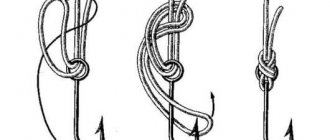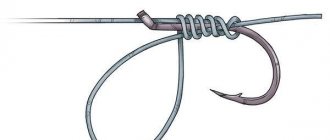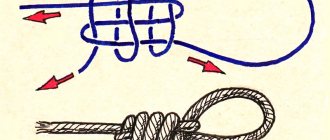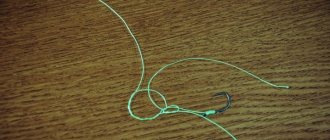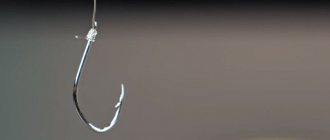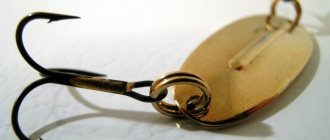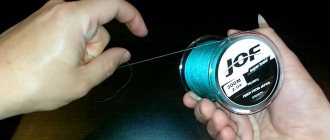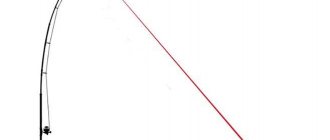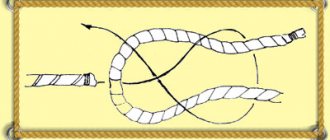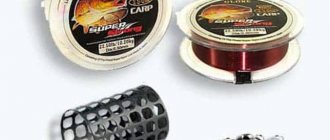Non-tightening loops
Gazebo knot
People unfamiliar with nautical terminology may think that the name "gazebo" comes from the verb "to chat" or from the noun "gazebo." In our maritime language, the name of this unit comes from the “gazebo”, but not from the usual one, but from a sea gazebo, which is a small wooden board - a platform used to lift a person onto the mast or lower it over the side of the vessel during painting or other work. This board is attached with the help of cables to the lifting cable with a special knot, which is called the gazebo knot. Its second name is bowline. It comes from the English term “bowline,” which refers to the tackle used to pull the windward side luff of the lower straight sail. This tackle is tied to the luff of the sail with a “bowline knot”, or simply “bowline”. It makes sense to dwell on this point in more detail. Indeed, it is admired by everyone who deals with cables and knot tying. This is one of the oldest and most amazing knots ever invented by man. Archaeologists testify that the gazebo knot was known to the ancient Egyptians and Phoenicians 3000 years BC. Not every sea knot can compare with it in the number of positive properties it possesses. Considering the scope of its application and excellent qualities, the arbor knot is rightfully awarded the royal title in the huge dynasty of maritime and non-marine knots. In appearance, it is similar to a weaving knot, but its running end does not go into the loop of the other end, but into the loop of its root end. The gazebo knot, despite its amazing compactness, simultaneously contains elements of a simple knot, half-bayonet, weaving and straight knots. The elements of all these knots in a certain combination give the gazebo knot the right to be called universal. It is surprisingly easy to knit, even with strong traction it never tightens “tightly”, does not spoil the cable, never slides along the cable, does not unravel itself and is easily untied when needed. The main purpose of the gazebo knot is to tie a rope around a person under the arms as a means of insurance when climbing to a height, lowering overboard or in a smoky room during a fire on board a ship. A gazebo can be inserted into the non-tightening loop of this knot. A loop tied with a gazebo knot on the mooring line reliably serves as a firelight. This knot can be successfully used for tying two cables of any diameter or for tying a thick plant cable with a steel one (in this case, the cables are connected with loops, and the knots are tied at their root ends). Of all the ways to connect two cables made of different materials (for example, hemp and steel, Dacron and manila), connecting using two arbor knots with loops will be the most reliable. It can be used for mooring and for attaching the cable to the hook. The reader is offered the most rational and simplest method of knitting. Always in life. Knowing how to quickly tie a bower knot around your waist can come in handy. You need to be able to do this with one hand, with one continuous movement of the hand, in the dark, in 2 - 3 seconds. It is not at all difficult to learn this. Take the main end of the cable in your left hand, and with your right hand, wrap the running end around your waist behind you. Take the running end in your right hand and, stepping back about 10 centimeters from its end, hold it in your fist. Take the root end in your left hand and extend your left arm forward. Now, with the root end of the cable slightly stretched, with your right hand with the running end clamped in it, bend the root end of the cable from top to bottom towards you and up from you. Try to make such a movement with the brush that it does not completely fall into the loop. Next, wrap the running end around the stretched root end to the left and intercept it with the thumb and forefinger of your right hand. As you pull the right hand out of the loop, simultaneously insert the running end into the small loop. Holding the running end with your right hand, pull the root end with a ribbon. After doing this several times in a row, you will learn how to tie a bower knot on yourself, in the dark or with your eyes closed. Imagine this situation: you find yourself over the side of a ship in the water, they throw you an end from the deck that you cannot climb up because it is slippery. By tying a bow knot around your waist and moving the resulting loop under your armpit, you can ensure that you are pulled safely out of the water and onto the deck. This magnificent knot has saved the lives of sailors more than once. To untie the gazebo knot, it is enough to slightly move the loop of the running end along the weakened root part of the cable.
up
Sea knots. Untightened knots
|
|
|
|
|
|
|
|
|
|
|
|
|
|
|
|
|
|
|
|
The picture shows a simple half-bayonet.
SIMPLE HALF PIECE. The simplest of non-tightening knots is widely used in maritime practice. Serves as the final element of many nodes. The running end of the cable is wrapped around the object on which it needs to be secured, then around the root end, after which it is passed into the resulting loop, and the running end is secured with a benzel to the root end. A knot tied in this way reliably withstands strong traction. It may move around the subject, but it will never be drawn in. A simple half bayonet is most often used to temporarily connect two cables.
In the picture there is a simple bayonet, where a is tied correctly, b is inverted, incorrectly.
SIMPLE BAYONET. Consists of two identical half-bayonets. The expression “throw on half a bayonet” means adding another carry-out to the knot already made by crossing the running end around the main one. The diagram shows a non-tightening knot widely used in maritime practice - one of the simplest and most reliable knots. To check whether the bayonet is tied correctly, you need to bring the two loops of the knot closer together. If this results in a bleached knot, this means that the simple bayonet was tied correctly. For such a bayonet, the running end, both after the first and after the second peg, should extend equally above or below its end. If the half bayonets of a simple bayonet are made in different directions, then when the cable is tensioned they will converge and the knot will be tightened, instead of a bleached one you will get a cow knot. The main use of a simple bayonet is to fasten the guy ropes of cargo booms to the butts and eyes, and fasten the cargo pendant to the load being lifted. Sailors often use two simple bayonets to temporarily connect two mooring lines. The maximum number of half-bayonets in such a knot, under any circumstances, should not exceed three, and the strength of the knot as a whole will not increase with a larger number of half-bayonets.
The picture shows a simple bayonet with a hose. SIMPLE BAYONET WITH SLAGE. It differs from a simple bayonet by one additional hose around the object to which the cable is attached. This knot is convenient for attaching a cable to a hook, fire ring, eye, etc. Two hoses around the object make this knot reliable, even during long-term use. The picture shows a simple bayonet with two hooks. SIMPLE BAYONET WITH TWO PINS. In fact, this is also a type of simple bayonet. The difference from the previous node is an additional, third hose. It increases the strength of the knot if the cable experiences constant friction against the bollard or biting. Using this unit to attach the cable to the hook is a very reliable method. The picture shows a bayonet with a rim.
BAYONET WITH BACK. If for a simple bayonet with two hoses the latter pass on the side of the attachment point of the root end, then with this unit they are placed one on each side. This makes the knot symmetrical; if the direction of traction changes, it moves less along the object to which it is attached. To tie a bayonet with a lead, you first need to make one hose around the object with the running end, encircle it behind the root end and make a hose again, but in the other direction. This is followed by one or two half-bayonets.
The picture shows a fishing bayonet or anchor knot. FISHING BAYONET (anchor knot). One of the most important cases of using a knot in maritime practice is tying an anchor rope to an anchor. Tested by centuries of experience, this knot is recognized by sailors of all countries as the most reliable for fastening a rope. A fisherman's bayonet or (anchor knot) is somewhat similar to a simple bayonet with a hose, but differs from it in that the first of the two half-bayonets additionally passes inside the hose, enclosing the object. When using this unit to attach an anchor, you should always grab the running end with a benzele to the main one. In this case, even with the strongest pull, the fishing bayonet does not tighten and holds securely. It can be used in all cases when working with cables when they are subject to strong traction. The picture shows a reverse bayonet. REVERSE BAYONET. Using a reverse bayonet, you can wrap the cable around the desired object once and at the same time tie a knot with two hoses around the object to which it is attached. To do this, fold the running end of the cable in half over a length of 2 - 3 m, and loop it forward around the object and pull the loop towards you. Now the running end of the cable needs to be threaded into this loop, and the slack should be taken out at the root end and the knot should be finished with two half-bayonets. A reverse bayonet is used in cases where access to the object on which you want to fasten the cable is difficult or inconvenient for tying a knot. The picture shows a mast bayonet.
MAST BAYONET. The combination of two knots gives a reliable simple knot. First, a bleached knot is tied around the object to which the cable is attached, and an ordinary bayonet is made at the root end of the cable, which, as is known, is also a modified bleached knot. To prevent the mast bayonet from becoming too tight, the first knot is not fully tightened.
The picture shows a towing unit.
TOWING UNIT. Used for attaching a cable to a towing hook or bit. Thanks to the sequential application of several cable hoses on the biting, the towing end can be etched from the biting, and when the tug tension weakens, it can be selected in the form of loops placed on top of the biting.
The picture shows a port node.
PORT UNIT. To hold the mooring end on the biting (palais), when there is no fire on the mooring line, a port unit is used.
First, around the biting, or bollard, you should make several hoses with the running end of the mooring line. After this, fold the running end in half and in this form, in a loop, pass it under the tensioned root part of the cable, then turn the loop 360° and throw it on top of the bit. The cable can be released at any moment, even if the mooring line is under strong tension. To do this, you need to slightly select the running end passing under the main one and increase the loop, after which it is easy to throw it off the biting.
California fishing knot for spinners
The image shows a strong "California knot" for tying a fishing lure, formed from double fishing line.
In addition to a spoon with vertical or horizontal wiring using a California knot, you can attach a wobbler, sinker, swivel, clasp, hook to the fishing line of the tackle.
To tie a spinner, fold the running end of the fishing line in half and pass it through the ring of the spinner “a”.
Then a simple knot “b” is knitted. The folded loop should not be short, since the next step will be to pass the attached spoon through it.
ATTENTION! In position “b”, the loop is first bent to the left behind the spoon, then the bait is passed through the loop (in the direction of the arrow). The folded fishing line is thrown over the tied fishing knot “b”.
Finally, the formed knot is moistened with water or saliva and tightened in several stages. A view of a Californian fishing knot fully tightened on a tied spoon is shown in position “d”.
Types of loops
Simple loop
Many fishermen do not accept overly complex connections, making do with the easiest ones. This point of view has a basis - the simpler the knot, the greater the chance that it will be tied correctly . The easiest way to tie a loop on a fishing line, perfect for monofilament and braid, is as follows:
- Measure about 10 centimeters from the edge and fold the fishing line in half.
- With the end folded in half, tie a regular figure-eight knot, keeping an eye on its size (the resulting loop should not be too large - then the tackle may get tangled, nor too small - in this case it may not always be convenient to use). Optimal size: 20-30 millimeters.
- Moisten the knot that is not fully tightened (water, saliva). Wetting is necessary so that the resulting knot heats up less due to the friction that occurs during the process of tightening it.
- Tighten (this can be done either by hand or by using various auxiliary objects - a knitting needle, a pencil, etc.).
- Carefully cut off the excess part (not close to the knot - otherwise it may come undone, but not too far from it, 1-2 millimeters of indentation will be enough).
California fishing knot for spinners
The image shows a strong "California knot" for tying a fishing lure, formed from double fishing line.
In addition to a spoon with vertical or horizontal wiring using a California knot, you can attach a wobbler, sinker, swivel, clasp, hook to the fishing line of the tackle.
To tie a spinner, fold the running end of the fishing line in half and pass it through the ring of the spinner “a”.
Then a simple knot “b” is knitted. The folded loop should not be short, since the next step will be to pass the attached spoon through it.
ATTENTION! In position “b”, the loop is first bent to the left behind the spoon, then the bait is passed through the loop (in the direction of the arrow). The folded fishing line is thrown over the tied fishing knot “b”.
Finally, the formed knot is moistened with water or saliva and tightened in several stages. A view of a Californian fishing knot fully tightened on a tied spoon is shown in position “d”.
What is the Loop knot used for?
The perfect loop is a seafaring and fishing knot. Typically, the knot and its modifications are used to create a loop that will not tighten at the end of a cable, rope or rope.
Many areas of human activity use the excellent qualities of the loop. For example, marine vessels, agriculture, industry and even in everyday life. But basically, as mentioned above, the loop is used by sailors and fishermen for various purposes. Boaters can use the knot to tie a tug, and fishermen can use it for anything, such as tying hooks to line or leader, tying main line and leader, tying up a boat, and much more.
